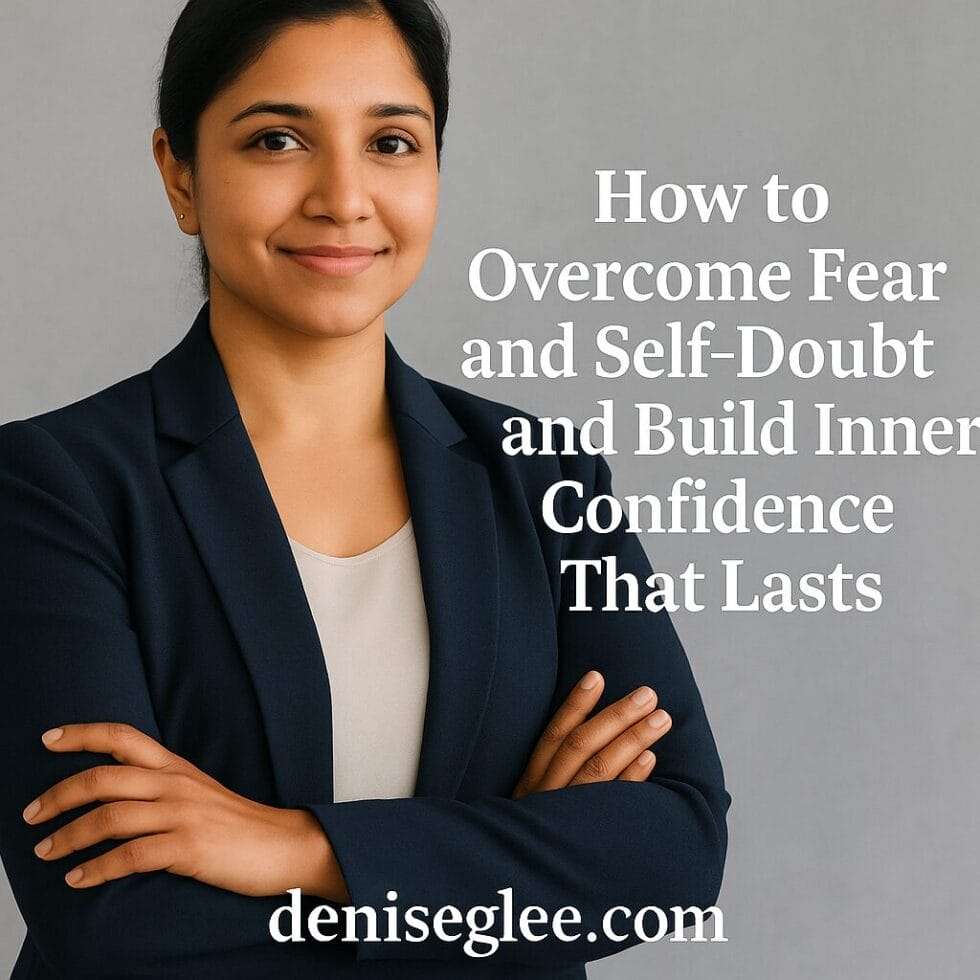
How to Overcome Fear and Self-Doubt and Build Inner Confidence That Lasts
- Published:
- Updated: May 16, 2025
You don’t need another “you’ve got this” pep talk.
You need someone to name what’s really going on.
You’re smart. Capable. Strategic.
But deep down, you’re scared as hell.
Leading meetings with shaky hands.
Second-guessing decisions you already made.
Smiling in front of clients while fighting the feeling that you’re about to be exposed, embarrassed, or abandoned.
And the worst part?
No one sees it. Or they don’t want to.
You’ve been told to “just believe in yourself.”
To act more confident.
To fake it till you make it.
But you know better now:
You can’t fake your way into peace.
You have to build it—brick by brick—from the inside.
In this post, I’m not giving you 11 cute tips.
I’m showing you what it actually takes to walk through fear and self-doubt with your spine intact—so you can build real inner confidence that lasts.
Let’s get into it.
Here’s What We’ll Walk Through Together
You’re Not Crazy—You’re Just Building Something Real
Let’s tell the truth because it needs to be said. We both know you’ve:
Cried in your car before a meeting.
Rehearsed one sentence of your pitch 17 times—and still hated how it sounded.
Talked yourself out of raising your rates, hitting publish, or sending the invoice… because deep down, it feels safer to struggle than to risk rejection.
Been praised for how “put together” you seem—while feeling like you’re falling apart.

But here’s the part nobody tells you:
It didn’t feel this heavy before, did it?
You were functioning.
Building big things.
Unfortunately, you were just surviving on adrenaline, hope and long to-do lists.
And then, somewhere in the middle of showing up again and again… the fear stopped feeling like a visitor and started feeling like a roommate.
You’re not losing it.
You’re just finally waking up to how much you’ve carried without rest, without help, without room to collapse.
This is the season when everything you buried for the sake of performance is surfacing.
It’s why your voice shakes during confident conversations.
Why you feel like disappearing after publishing something bold.
Why your nervous system is reacting like you’re in danger—even though nothing “bad” is happening.
So girl, I know—
You’re not broken.
You’re not behind.
And you certainly aren’t too sensitive, or too slow, or too much.
You’re just tender from years of holding it together.
And tender doesn’t mean weak.
It means you’re finally telling the truth.
You’re still in it—scared, shaking, showing up.
That’s not failure.
That’s emotional courage in motion.
Fear Is Natural—But It’s Not Your Enemy
You think fear means something’s wrong.
But what if it just means you’re finally doing something real?
Fear isn’t weakness.
Fear is biology.
It’s the brain pulling the emergency brake as soon as you try to shift lanes—even if that lane leads to freedom.

This isn’t theory. I’m living it right now.
I’ve written about sex addiction and emotional trauma without a credential to “legitimize” me.
I’ve talked about sobriety, incest, and recovery—not in private, but in public—knowing full well that someone might twist my story or question my authority.
It still scares me.
Not because I don’t believe in what I’m saying.
But because my nervous system remembers what happened when I told the truth before—and wasn’t believed, protected, or supported.
Your body doesn’t know the difference between rejection from a client…
and rejection from your tribe 10,000 years ago.
It just knows that standing out feels dangerous.
That’s why your hands shake when you’re about to hit publish.
Why you feel stomach knots when you speak up in a room full of experts.
All those tiny acts of bravery can leave you emotionally wiped out.
You’re not weak.
You certainty are not unqualified.
And don’t ever call yourself an imposter.
“The human brain is wired more for survival than for truth.”
— Brené Brown, Daring Greatly
So no, you don’t need to be fearless.
You just need to stop mistaking fear for failure.
Stop letting fear disguise itself as “being wise” or “being careful.”
Let it rise.
Shake it all out.
Let it exist.
And still choose to speak.
Because your story matters.
Even when it costs something.
Tools to Rewire the Fear Loop
Not tips. Tools. Because this isn’t hypothetical—it’s your real life.
Becoming brave doesn’t mean becoming numb.
It means training your nervous system to stop mistaking your future for danger.
That takes time, practice, and a different kind of leadership—one that begins inside.
These tools aren’t about hacking your mindset or grinding your way through anxiety.
They’re about creating an emotional rhythm that lets you move through the fear—instead of letting it move you.
Here are 11 tools I’ve used myself—and with my clients—to build inner confidence one brave breath at a time:

1. Identify your real fears (not just the surface ones)
Fear isn’t just “I don’t want to fail.”
It’s often: “If I fail, I’ll lose love.”
Or: “If I succeed, I’ll be alone.”
Write them out. Be brutally honest.
You’ll often find that your biggest fears are tied to emotional memory—not actual risk.
2. Stop worshiping goals—make PACTs instead
Instead of SMART goals, use PACT:
Purposeful, Actionable, Continuous, Trackable.
This helps you stay in motion without needing constant performance highs.
Use this structure when you feel the urge to go big and crash.
3. Shrink the fear into micro-movements
Don’t go straight to “speak at the conference.”
Start with: “record a 2-minute voice memo to myself practicing the pitch.”
Fear breaks apart when you shrink the moment.
4. Let discomfort be your signal—not your stop sign
Your body will say “no” when you’re just about to grow.
Create grounding affirmations that meet your fear with truth, not fantasy:
| Change | Fear | Reframe |
|---|---|---|
| Launching your offer | “No one will buy this.” | “My people can’t find me if I stay silent.” |
| Hiring again | “I’ll just be disappointed again.” | “I can discern better now—I’ve grown.” |
5. Normalize setbacks (they’re not moral failures)
You will feel like you’re going backwards.
That’s part of forward.
Remember: a relapse in doubt doesn’t erase your growth.
6. Create higher standards—without shame
If you’ve survived trauma, being “functional” can feel like winning.
But you’re here to thrive, not just cope.
Ask yourself:
What am I tolerating that I’ve outgrown?
What am I afraid to demand from myself?
Write your answers where you’ll see them every day.
7. Visualize with full sensory detail
This isn’t woo. It’s rewiring.
Picture yourself:
Getting the support you’ve prayed for
Sitting at the table you used to feel unworthy of
Let your brain start believing it’s safe to be seen.
8. Take aligned risks—not desperate ones
Don’t “burn the boats” unless you’ve got emotional fireproofing.
Ask:
Does this risk honor my values?
Would I still take this risk if no one applauded?
9. Treat failure like a teacher—not a curse
Failure is data.
It’s also an initiation.
Ask: What does this setback make possible?
Then build with that.
10. Don’t do this alone
Accountability isn’t just about productivity.
It’s about having someone who reminds you who you are when you forget.
Find someone who’s walked through fear—and didn’t numb it away.
11. Celebrate the tiny brave things
Every time you choose movement over avoidance, that’s a win.
Track it. Name it. Write it down.
Let bravery become familiar—not just impressive.
💛 Reminder:
This isn’t a checklist.
It’s a rhythm.
And every single one of these tools is something you can return to—when the fear hits again (because it will).
Final Thoughts: You Don’t Have to Feel Ready to Begin
You don’t need to wait until the fear disappears.
Save your money. You don’t need another credential to speak truth.
And time to drop the idea that you need a guarantee to move.
You just need to stop performing bravery—and start practicing it.
Because the confidence you’re looking for?
It doesn’t come from being perfect.
It comes from showing up scared, again and again—until your nervous system learns it’s safe to stand tall.
You’re not behind, broken or crazy.
You’re just building something real.
And that? That’s sacred work.
Go Deeper
If you’re ready to stop performing and start healing—for real—I’d be honored to support you.
💛 Work with me, Denise G. Lee – Together, we’ll untangle the deeper patterns holding you back and create clear, practical strategies that match you. No hype. No formulas. Just honest, personalized support.
👉 Explore working together
🎙️ Want more real talk like this?
Listen to my podcast for unfiltered conversations on emotional growth, leadership, and the truth about healing in business and life.
👉 Introverted Entrepreneur – wherever you stream
💌 Got thoughts or questions about this article?
I’d love to hear from you.
👉 Write me a note
And just in case no one’s reminded you lately:
Leadership isn’t about being perfect.
It’s about being present. Being willing.
Showing up with your scars, not just your strengths.
That’s what makes it powerful.
That’s what makes it real.






Add A Comment
You must be logged in to post a comment.